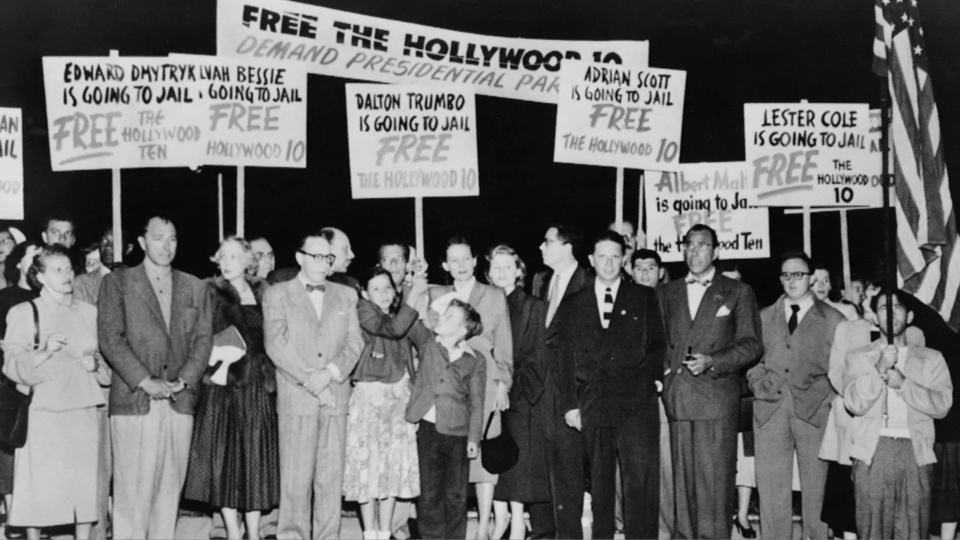
Near the end of his life, Albert Maltz looked back on his career as playwright-novelist-screenwriter and wistfully reflected, “It is not new for me to write something that falls like a pebble into a deep well.” Maltz spoke these words in an interview with a theater scholar who had asked, “Why wasn’t The Morrison Case ever performed or published?”
The reasons were political, the story painful. The Morrison Case was not a pebble but a powerful drama, an antifascist hand grenade that nonetheless fell silently into the deep well of a suffocating American Inquisition.
It was the first thing Maltz wrote after his release from the Mill Point Prison Camp in April 1951, where he’d served ten months for contempt of Congress. As a member of the notorious Hollywood Ten, he had challenged the constitutional legitimacy of the House Un-American Activities Committee and refused to cooperate with its investigation into alleged Communist subversion. Though his time behind bars was over, his second punishment—blacklisting—was just beginning.
Scripting a hard-hitting play that was hostile toward HUAC was likely a therapeutic exercise for the traumatized ex-convict. But with the Red Scare raging and the term “McCarthyism” just entering the American lexicon, the end-product of Maltz’s effort was of course foredoomed.

The playwright tried to find a producer brave enough to stage The Morrison Case in 1952-53, but there was no market for it anywhere in the United States. In 1956, it was performed on a Berlin radio station in the German Democratic Republic, but until now, the play has never been published or performed stateside. It has been available only as a 44-page typescript preserved in Maltz’s archived papers at Boston University.
The long-awaited audio production, just released by Fermat’s Last Theater Co. of Madison, Wis., changes everything, giving The Morrison Case its first-ever airing for the English-speaking world.
The play, based on an official legal transcript, is about Peter Morrison, a machinist for 18 years in the Brooklyn Navy Yard, who is accused of Communist affiliations (largely because of his wide-ranging reading habits) and summoned to a Loyalty Board Hearing in 1948.
Before his interrogation begins, Morrison confidently takes a letter from his pocket, laughs, and asks the Loyalty Board a routine question: “The person who asserts I’m a member of the Communist Party…I’ll get a chance to confront him, won’t I? So I can disprove him in front of you?”
Informed that he won’t get this chance, Morrison is confused. The rules for the hearing “come from Washington,” he is told, and such information is confidential. At this he becomes uneasy, with good reason. It’s his first indication that for people like him, at this moment in U.S. history, the Bill of Rights is a dead letter. This is the same lesson Albert Maltz and the Hollywood Ten learned in their confrontation with the House Un-American Activities Committee.
So how did this happen? How did the country reach this point?
After World War II, tensions between the U.S. and the Soviet Union quickly escalated, as did exaggerated fears of Communist infiltration. In the 1946 midterm elections, conservative Republicans won firm majorities in Congress by claiming that the Roosevelt administration had “harbored Communists” and that current Democrats, including President Harry Truman, were soft on Communism. Realizing that they were onto a winning formula, the right wing ramped up its alarmist rhetoric. They claimed to embody patriotism but were in fact the vanguard of a resurgent American fascism.
President Truman’s executive order 9835, issued in 1947 in response to growing criticism from conservatives, instituted loyalty oaths and a vast program of loyalty hearings for federal employees.
Under the order, J. Edgar Hoover’s FBI was given the authority to compare the names of millions of federal workers with the membership rolls of a long list of organizations deemed subversive by the Attorney General. If suspicious or “derogatory” information was found, FBI field investigations were initiated.
The files from these investigations were forwarded to more than 150 loyalty boards in various government agencies and industries, where loyalty hearings were then conducted, often using testimony from confidential witnesses. The legal standard for dismissal of employees was vague. Workers could be fired on the basis of “reasonable grounds for belief in disloyalty.”
Under this highly flawed system, loyalty hearings like the one in The Morrison Case became weapons of terror that attacked law-abiding citizens. Between 1947 and 1955, over five million federal workers underwent screening, resulting in 2,700 dismissals and 12,000 resignations, according to recent research. As Richard Kirkendall’s study of Cold War-era civil liberties concluded, “the program exerted its chilling effect on a far larger number of employees than those who were dismissed.”
The loyalty initiative also had a chilling effect on U.S. society in general. Informers were encouraged to turn in fellow citizens and praised from pulpits by religious leaders. Left-leaning professors were fired. Schools required loyalty oaths for teachers and began to remove tainted literature from their libraries, including the works of Albert Maltz. The Morrison Case starkly displays the workings of what British journalist Cedric Belfrage called “The American Inquisition.”

In the new audio drama, Tom Kastle interprets Peter Morrison’s shock and panic as the Loyalty Board administers its torture. Kastle’s acting is informed by both the spoken script and Maltz’s stage directions, which are not read aloud but carry substantial meaning.
A listening audience should be aware, for example, that the play’s brief opening scene is set in 1952, four years after Peter Morrison’s loyalty hearing, and that it’s about poverty. Morrison, 40-odd years old, is standing on “a street corner in winter…wearing a shabby overcoat and battered hat.” A former master machinist with a rating of Excellent, he now survives by hawking newspapers. “It is night. Not many people are passing.”
Morrison is approached by Butler, a man in his thirties carrying a briefcase. He buys a paper, and there is a moment of mutual recognition. Butler had been the lead investigator at Morrison’s loyalty hearing. The two men “stand glaring at each other with frank hostility and mutual contempt. The light dims on them.”
After a pause, the spotlight rises and we are in 1948. A Naval Captain is seated behind a long table with two middle-aged civilians on either side of him. “The three men compose the Loyalty Hearing Board.” Investigator Butler is seated at a separate, smaller table, stage right. And, as the script reads:
“Facing them, seated center stage in an office armchair, is Morrison…. He smokes cigarettes steadily and with an increasing nervousness throughout the scene. He is wearing his ‘Sunday’ suit. At upper right is a stenotypist, who takes notes whenever anyone speaks.”
A second stage direction I want to call attention to is on page 28 of the 44-page manuscript. Morrison is defensive and wary because, as the manuscript reads, “From now on he knows that the Board members are also his enemies. And from now on he is fighting less to retain his job than his self-respect, very grimly.” Getting inside Morrison’s mind and heart this way helps explain exactly why, a few seconds later, he tensely “rises from his chair, stops and sits down again.”
Finally, in the last few pages of the manuscript, we reach the emotional climax of the play and the moment when Morrison can no longer hold himself in check.
The Naval Captain asks, “Do you wish to add anything for the record, Mr. Morrison?”
After a pause, Morrison answers, “Yeah…yeah I do.” Here are Maltz’s stage directions for this moment:
“[Morrison] looks at Board members, then crosses to water cooler. He drinks a cup of water, starts to throw cup away, then takes half a cup more and drinks it. Returns and stands in front of Board.”
Postured and positioned defiantly at center stage, Peter Morrison delivers a monologue castigating the Board and its bigotry. By implication he also condemns the political order that has allowed them to rob him of his livelihood and, in a sense, his country. Then he tells them what they can do with his job.
When he’s finished, the lights dim, and we return to 1952 and to the streetside encounter between Butler and Morrison.
The tension in the conversation between the two men increases. Butler is still a smug, ignorant man, perhaps inwardly shamed about what the capitalist state has made him do. He resorts to slurs and red-baiting, calling Morrison a Communist and a crackpot.
But Morrison’s blacklisting has changed him—turning him into an activist.
The final words of the drama prompt the audience to think about patriotism. Butler’s conservative, “my country, right or wrong” patriotism is cowardly. Morrison’s alternative—“my country, right your wrongs”—is a path of courage and principled civil disobedience that puts him in a category of citizens like Albert Maltz.
The premiere performance of The Morrison Case is available here. It was made possible by a grant from the University of Akron and kind permission from the executor of Albert Maltz’s Estate, Mr. Dov Engelberg. If you are moved by the 50-minute play, consider supporting the stated mission of Fermat’s Last Theater and its actors: “Serious Theater; Radical Truths; Always Free.”
We hope you appreciated this article. At People’s World, we believe news and information should be free and accessible to all, but we need your help. Our journalism is free of corporate influence and paywalls because we are totally reader-supported. Only you, our readers and supporters, make this possible. If you enjoy reading People’s World and the stories we bring you, please support our work by donating or becoming a monthly sustainer today. Thank you!












Comments